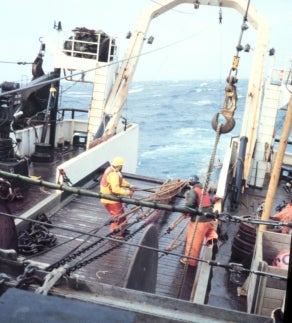Today, fishing once again topped the Bureau of Labor Statistics’ list of most dangerous jobs in the U.S. In 2010, commercial fishing had a fatality rate per 100,000 full-time-equivalent employees 33 times the average rate for U.S. workers. Although fortunately fishing’s fatality rate did decrease from 2009, it remains true that fishermen faced the highest chance of dying on the job compared with other occupations in the U.S.
Many things make fishing dangerous, but the way we regulate the industry can make things worse. For example, regulators often manage fishing by limiting when fishermen can be on the water, such as by setting short seasons, allocating a limited number of days at sea or shutting down a fishery when too many fish have been caught.
In order to catch enough fish to stay in business, fishermen must race to catch them before others do, which can lead to fishing in dangerous weather conditions, keeping exhausted crews on the water and overloading boats with excessive gear. All of these methods maximize catch in the short term but risk lives.
In contrast, catch shares give fishermen a secure amount of seafood they don’t have to race their peers to catch. Catch shares provide flexibility to choose when to fish based on the weather and market conditions.
The benefits are significant. The Alaska crab fisheries shown on the Deadliest Catch TV show have become much less dangerous under catch shares. In the five years before catch shares took effect, eight people died in the Bering Sea/Aleutian Islands crab fisheries. In the six years since the fishery switched to catch shares in August 2005, there’s been one fatality.
In a letter to the National Marine Fisheries Service, Edward Poulsen of Alaska Bering Sea Crabbers asserted that, “the Crab Catch Share Program has been the most important regulatory change in the history of the crab fishery promoting safety of life at sea.”
Similarly, the number of search and rescue missions for Alaska’s halibut and sablefish fishery went from 26 and 33 in 1993 and 1994 respectively, the last pre-catch share years, to 3 in 2009 and 2 in 2010 under catch share management. More than 85 percent of Alaska halibut fishermen surveyed found fishing to be safer under catch shares.
Where conventional management still holds sway, pressure to fish under dangerous conditions persists. Jack Cox, a fisherman from Morehead City, North Carolina fishes in the South Atlantic’s vermillion snapper fishery, which regularly closes down early, as well as the region’s black sea bass fishery, which was shut down after just 45 days this year. He explained, “Fishermen are asked to choose between their safety and their bread and butter. We’re in a race to catch as many fish before the fishery gets shut down. The vermillion snapper season opens in January when the weather is nasty and there is pressure to fish while we can. My boat was damaged during a bad storm to the tune of $6,000.”
In some respects, fishing is inherently a more dangerous way to earn a living than many other jobs. But catch shares eliminate the race to fish that makes fishing more dangerous than it has to be.










